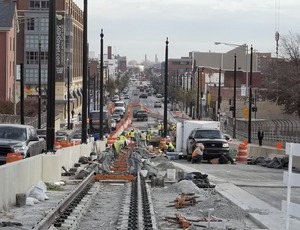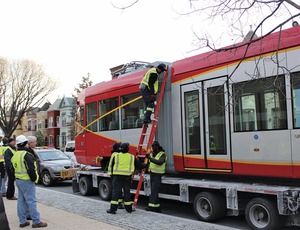

Construction of a 2.4-mile starter line for Washington, D.C.'s first streetcar in 50 years symbolizes both the city's efforts to revitalize its Anacostia waterfront areas and a growing national transportation trend.
Officials with the District Dept. of Transportation (DDOT) publicly unveiled the first streetcar this month. The design-build joint venture of M.C. Dean Inc. and Facchina Construction Co. Inc., under a $50-million contract, installed overhead catenary wires, open-cut-excavated H Street amid burgeoning commercial development and historically sensitive sites, constructed substations and laid track.
"It looks like simple construction on paper," says Thomas Perry, DDOT program manager. "But within the street, throughout, are the power and gas lines, water and all the utilities." Some of the duct banks were a century old, adds Thomas McFall, a joint-venture manager. "We all worked hard to develop good relationships with the utilities," he says.
Relationships with historic preservationists were also key. The streetcar's operations and maintenance facility, under construction, is located on a site recently designated as historic, due to a formerly segregated high school. The "car barn" had to go through major redesigns and scrutiny; it will feature a workforce training center and conference room.
Lessons learned on the initial 2.4 miles of construction will inform the second 22-mile phase, for which DDOT aims to solicit design-build-finance-operate-maintain teams after the environmental permitting process is complete. DDOT studied other public-private partnerships across the nation, such as Denver's Eagle P3 project.
Washington, D.C., is among American cities reviving streetcars, says David Vozzolo, head of streetcar practice for HDR Inc., the project designer. "We're involved in 20 to 25 projects in various stages," he says. "This is the busiest time for streetcar projects in modern times."
The streetcar cities are considering "modern-day systems" that replicate routes once traversed by trolleys before vehicles displaced them, he says, pointing to projects in Salt Lake City, Tucson, Atlanta and Kansas City. A $133-million project in Cincinnati recently restarted after a politically charged hiatus.
Washington, D.C.'s streetcar project is part of a larger effort to upgrade infrastructure and spur an economic renaissance in Anacostia River communities. Another big project, the $900-million South Capitol Street Corridor, entails design-build to replace the Frederick Douglass Bridge. The five-lane existing bridge has no stormwater treatment system and an old pin-and-hangar system, says Sanjay Kumar, DDOT program manager, Anacostia Waterfront Initiative. "To maintain the old bridge, it would cost $100 million over five years," he says. The new bridge will have six lanes and a 1,600-ft-long main span.
The improved corridor also will include a new interchange, a new traffic oval and a six-lane boulevard, footpaths and improved stormwater retention systems, says James Moorcroft, DDOT design manager. Fiber-optic cables, military property and contaminated fuel facilities all had to be taken into account, he says. DDOT will short-list up to four out of seven groups who responded to a statement-of-qualifications request.
With all these projects, "the river will no longer be a barrier" to community and economic development, says Kumar.

Post a comment to this article
Report Abusive Comment